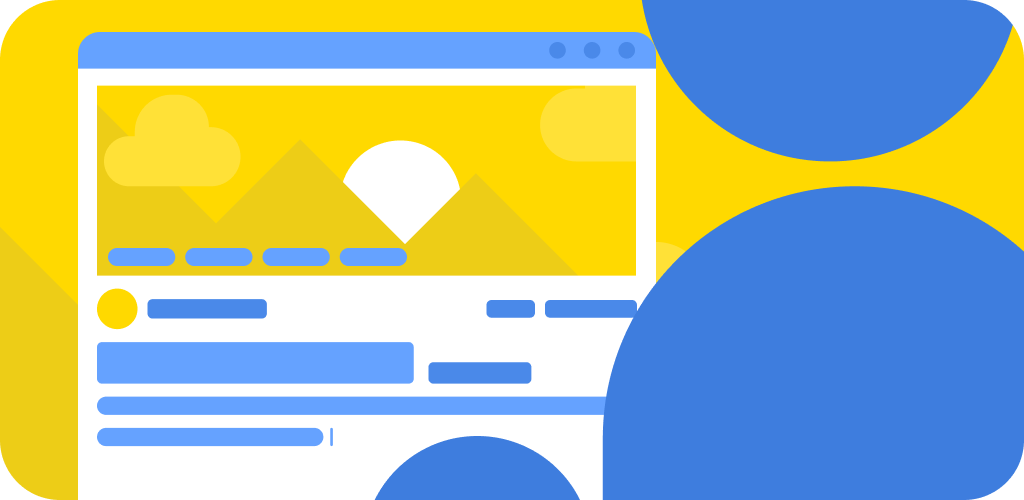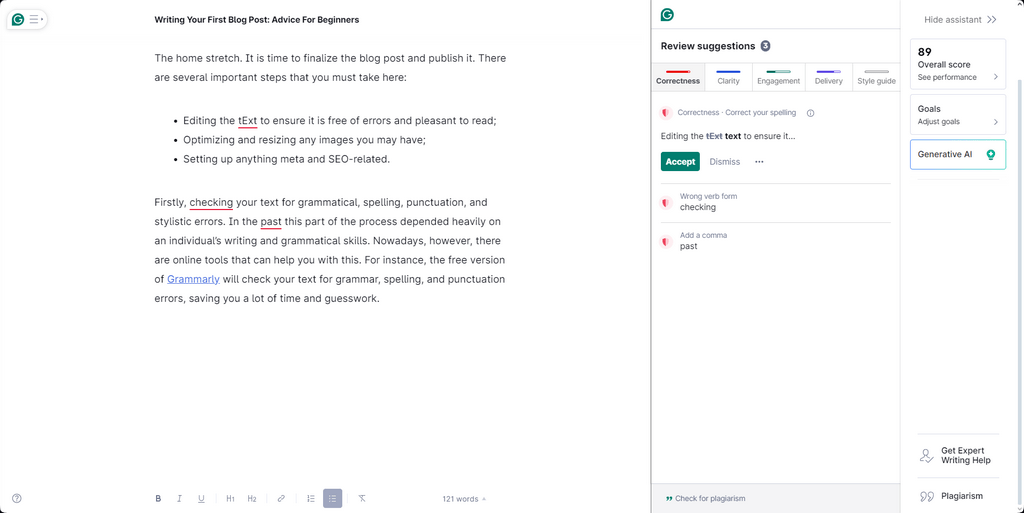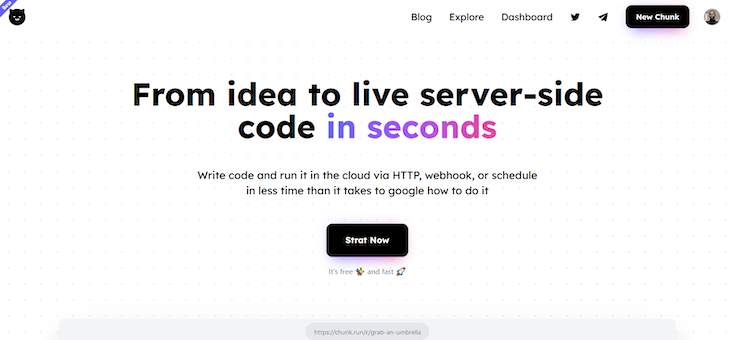Undoubtedly, the first step is one of the most challenging things to do when starting a new project. Where do you begin? How do you begin? Is this the perfect point to start with? What if I am missing something better? We have all struggled with questions like these. Even here, at FastComet, when writing a blog post, the introduction is one of the hardest things to get rolling. Beginning can be a struggle, especially when it is something as important as your first-ever blog post on your website. That is why we wanted to share our experiences and knowledge.
In the following few paragraphs, you will learn how to write a great first blog post and perhaps shake off that initial paralysis when starting something from scratch. Telling you how to do it is an excellent way for us to help. Still, an even better way is if we also teach you how to alleviate those feelings of uncertainty.
Why is the First Blog Post So Important?
Table of Contents
There are many reasons why the first blog post you publish is essential. The most significant one is that it sets the tone and expectations. It will be the first impression your visitors get. As we all know, first impressions typically last forever or are very difficult to change. That first post will be the introduction to your content, whatever it may be, and will set the bar of expectations.
No pressure, right? It is a very daunting task when you think about it in such a macro way. What if it is not perfect? Or if your message doesn’t matter? What if people aren’t interested in what you have to say? Anyone who has written and published anything online has suffered through those questions. Here are a few things to help you shake off those frustrating questions.
- You are likely writing out of passion for yourself. Create your post to the level of excellence you are content with. Even if you are not, you should try to shake off this notion of “perfection.” It will only hold you back, and you may even fall into an endless cycle of constant edits and revisions. Write to your satisfaction and hit that “Publish” button;
- Oftentimes, expressing our opinions is viewed as entitled nowadays, and we can understand why you might be reticent to speak up. Shake that feeling off! You are writing to express yourself, so do so with confidence. Whether it is just to get something off your chest or actually try to find like-minded souls online, this blog is your space for your opinions. If they matter to you, then that is enough;
- Finally, you can blog on just about any topic, and you will find an audience. It can be something very obscure, like quoting folk advice from centuries ago (Our favorite is spa treatments to treat werewolves). You can also write about a trendy topic, like tech news. We don’t need to give you a link to such blogs; there are countless of them online.
Ultimately, your initial blog post will be the introduction most visitors will see or look for. It will show readers what you are writing about, how you write it, and the quality and information you are offering. We assume you are writing out of personal desire because that is what most blogs are about. With that in mind, your initial blog post should be free of errors – most importantly – and also be compelling and well-structured enough to keep a reader’s attention. In that context the topic does not matter because you want interested readers; those who aren’t will simply not stay.
Where to Start?
The best place to start your first blog post is with a couple of fundamentals: the topic and the platform you will use. There are a lot of considerations and choices to be made here, so allow us to give you some advice. If you already have an idea, though, that’s awesome! You are one step ahead! If not, the following few paragraphs should help you decide.
Decide on a Topic

Firstly, ensure you are passionate about what you want to write. Blogging about a topic you don’t feel at heart can become tiresome, boring, and even frustrating. So, finding the right topic for you is critical. Here is our advice: ask yourself what you would be excited to read about in other people’s blogs. Brainstorm at least several topics, and don’t cling to the first one you come up with. Having a small amount of choices here is good since you will be more likely to make the correct decision this way. An excellent way to find out what you are passionate about is to answer some or all of these simple questions.
- What gets me excited when I think about it? – The most simple yet sometimes most difficult question to answer for yourself. We are so used to the things that bring us true joy that we sometimes don’t even realize it. Do you get giddy when you think about advancements in AI? Do you adore brainstorming about fantasy settings? Really think about this one;
- What have I surrounded myself with? – Look around your room or think about your friends, and seek inspiration there. Oftentimes, we surround ourselves with things or people that are in some ways connected to our passions. Do you have a lot of sports friends or memorabilia in your room? Maybe gaming trophies and an online squad you conquer ranked games with? Inspiration can often come from the outside world;
- Who do I want to help out, and with what? – Sometimes, some people have blogs to help others and themselves in the process. If you already know you want to have such a blog yourself, then consider who you want your audience to be, and make sure you have some expertise in the field you will be writing about. This one is important, as people seeking help will often double-check the information they find online. You don’t want to lie to your audience;
- What do I have experience with? Am I willing to learn? – This question goes hand-in-hand with the above one. What are you good at? Gaming? Woodworking? Fixing cars? Really consider where your skills lie and if you are willing to expand those skills. If you already have a job that has allowed you to learn a skill of any kind, and you genuinely have a passion for it, then that’s a great place to start;
- Can I use my own life experience? – Finally, this is very self-explanatory. Life experience should not be underestimated. You don’t always need to be proficient in a skill or have academic knowledge to feel confident about writing on a topic. Especially if that topic is more esoteric or not something you can typically “learn.” Emotional support is one such topic, where life experience is endlessly valuable, for example.
We even recommend you write a few short essays or paragraphs on a random topic related to the passions you have decided on. That way, you can see what you feel the most comfortable, confident, and happy with. Unless you are in a rush, you should take your time to do this. It is not the end of the world if you realize what you have chosen is not what you were expecting, though! You can always start over, and the upside is you have gained valuable experience from the process.
Additionally, here is a quick list of niche ideas that you can consider if you would like to dive into something brand new. These ideas are not the most popular on the internet, but there is a high demand for them. That may improve your chances of getting discovered and garnering an audience.
- Healthy eating and nutrition;
- Personal finance and financial responsibility;
- Home cooking, especially if it is quick and easy;
- Fitness advice for exercises at home;
- Upcycling and repurposing;
- Home organization;
- Any sort of craft: wood, knitting, metalwork, etc.
Finally, we wanted to direct your attention to another blog we posted. It is about turning your online passions into a business. You should check it out as well since we discuss similar topics: declaring your passion, doing the necessary research, and so on. It can give you even further inspiration to discover or decide on the topic you want to write about.
Decide on a Platform
You have chosen the topic for your blog, perfect! Now, it is time to decide which platform you will use to lay your thoughts and experiences out for the world to read about. Right off the bat, our recommendation is WordPress. It is a versatile and beginner-friendly platform with tons of excellent features. Even if all you want to do is put text on a web page, it is still our recommendation because evolving past that point will be easier with a platform like WordPress. We have extensive guides and tutorials about WordPress that can help you get started. You even have the choice of hosting a website with a company like FastComet or using their self-hosted WordPress.com services.
WordPress is not the only blogging platform out there, though, so here are a few things to consider if you are choosing between several blogging solutions.
- Are you looking for something that is beginner-friendly and does not require a lot of prior knowledge to use it?
- Will you be monetizing your blog?
- Is multimedia going to play a large part in your blog? Things like images, videos, and music;
- Is the blog there to boost the visitor numbers of your business website through SEO?
- Will the blog be more of a hobby, or are you trying to distinguish yourself as a leader in the sphere?
If you don’t want to use WordPress, then you should definitely do your research on the various blogging platforms online. To make that research a bit easier for you, though, here is a couple of the better solutions online.
- Blogger – On the other hand, Blogger has a free version that is more than sufficient. With it, you can create stylish, interesting blogs without spending any money. However, as it is not a Content Management System, unlike Squarespace, where you make a whole new website for your blog, its functionalities will be pretty limited. Nonetheless, it is an excellent choice for those who do not need such CMS functionalities;
- Tumblr – If you want to focus on a more visual blog, then Tumblr is a decent choice. It is better suited for blogs that showcase a lot of images or short videos instead of lengthy written pieces. Nonetheless, if you are looking to create a blog that focuses more on train-of-thought writing and a lot of visual media, consider Tumblr. It is free, and if you manage to foster a community, then you can also monetize it.
These are both excellent if you want to dip your toes into blogging and learn the ropes. They have robust tools to create your blog and first post. However, our advice is to consider solutions like WordPress if you want to not only learn how to create a website but also create a thriving community around it and ultimately earn money. A CMS platform like WordPress has all the necessary tools to blog. Still, you can also expand it into a fully-blown website if the need arises.
Writing the Blog Post

The time has come to put words to paper, or a blank text field in this case. This is probably the most difficult task of the whole process. Hitting “Publish” is the most daunting one, on the other hand, so you are in for a ride!
How do we start, though? That is the eternal question, isn’t it? Fortunately, we are here to give you some advice that should hopefully get you through this hurdle. Firstly, of course, you need to choose where to write your blog post. You can just use the text editor of whichever platform you decide to host your blog. All of them are perfectly fine. However, our recommendation is to use a cloud service, like Google Drive, or create a file on your local machine. Or both if you want to be extra backed up! We find Google Drive sufficient enough as it offers excellent functionality and reliability. The free space you get with any Google account should also be more than enough, even to store media on it.
With the blank text field and cursor blinking on your screen, you are probably wondering what the first sentence should even be. Already stuck, and you haven’t even started! Don’t worry, though! Most people struggle with precisely this, so here is some advice on how to get those creative juices flowing.
You don’t need to implement this advice in the order we are giving it. Sometimes you will have an easier time writing the body of your post and formulating the title around it or vice versa, for example.
Create an Interesting Headline
The first thing anyone will see is your blog post’s headline. As you can imagine, it is imperative that they get hooked the moment they are done reading that headline. An excellent way to think about this is to imagine it is a headline in a newspaper or news website. Would you read an article with what you just wrote above it? Try to be as objective as you can be here! You should always divulge enough information about the topic of the post but not enough to give it all away. That would defeat the purpose of reading the post itself.
There are many approaches you can take to the headline style itself, but there are a few that we recommend.
- The List – Readers love list posts. They combine the compelling nature of the title with the feeling of self-validation or satisfaction we get when reading them. Not only that, but you can also show some genuine knowledge and expertise through such a post. We want to know what is on the list and what is not! It is quick content; we can scan through it and see what it offers and read only what we want. Here are a few keyword suggestions;
- Quick Tips;
- Never Do;
- Ways to/not to;
- Reason to/not to;
- Facts You Didn’t Know;
- The “How-to” – Another magnetic headline type is the “how-to.” People love just to type what they need to do in Google and get a slew of easy-to-follow instructions. Such posts typically lead to action as well, so you can easily and quickly build a community if you offer quality instructional pieces. It also satisfies our need for accomplishment: not only do we know how to do the thing, but we have also succeeded because of the blog post we just read. It is a solid choice for a first post. Here are some example titles;
- How to/not to accomplish something;
- How something can help the reader in some way;
- Some steps to accomplish something;
- The Introduction – We recommend starting here. Writing a “list” or “how-to” post is not a bad idea to begin with. An introduction is much more natural, though, and you will have an easier time informing the reader what your blog is about. That way, you won’t have to worry about sticking to the topic of the former two, and you will focus entirely on telling the reader about yourself and your blog. It is also easier to write because it comes entirely from your own knowledge and experience: no guesswork or research is needed! Depending on the topic of your blog, you can use a title similar to one of these;
- Welcome to (Name of your blog), Your Ultimate Guide to (The topic of your blog);
- How (Name of your blog) Will Help You With (Topic of your blog);
- Introducing (Name of your blog): Where (The topic of your blog) Enthusiasts Gather;
- Step Inside (Name of your blog) and Learn About (The topic of your blog);
- Hello World! Meet (Name of your blog) and Explore (The topic of your blog).
Finally, on the topic of blog post titles, you can use an online tool, such as Capitalize My Title or AIOSEO, to analyze the headline you have chosen. You should be able to glean some valuable insight about it. Don’t worry too much about the score, and focus on the advice you will get from the tools themselves.
With this said, we believe that you are now more than capable of coming up with an excellent article for your first blog post!
Plan and Outline Your First Blog Post
Has this happened to you? You sit down, ready to write, but then suddenly, all your creativity and motivation is gone. Indeed, this has happened to us, and we know it is something many writers struggle with from time to time. The solution is not to sit and wait for inspiration to happen, though. You have to sit down and more or less force those creative juices flowing. Once you get into the groove of writing, you will feel so much better. After all, we – as human beings – very rarely feel ourselves into action and instead act into a feeling.
One solid way to help yourself with the creative process is to write a plan or an outline for your blog post. You can do this before or after you have chosen a title. Having a very clear idea of what you want to write about in terms of individual topics within the post itself will be such a massive help to your process. For example, if you are creating a “list” post, then you should definitely note down each item you will be discussing and add a small description as a reminder of what the item is about.
For a “how-to” post, you should think more beginner-friendly. We all forget that at some point, we also didn’t know how to do something, so when explaining, we may omit some steps because we think they are obvious. To a beginner, they might not be, so we recommend starting from the genuine beginning and not forgetting any consecutive steps. Try to be as detailed as possible without being pedantic or bogged down in details.
Finally, if you are writing an “introduction” post, we strongly suggest you keep it reader-oriented instead of focusing on yourself. Yes, you will be introducing yourself and the subject of your blog, but it is the reader who ultimately matters the most. Make it about them and show them how this blog will help them. Here is an example structure you can follow.
- Introduction – Here, you can talk about yourself briefly and concisely. Same about the blog post itself. You can briefly mention some of your experiences and skills without going into excruciating detail. Establish baseline credentials to show the reader that you know what you are talking about;
- Why are you writing the blog? – It is a good idea to explain next why you created the blog in the first place. Here, you can share some personal experiences or anecdotes that motivated you to create the blog. Again, however, keep it brief and to the point. If you want to elaborate on any of your stories, you can always do that in a separate post altogether;
- How will this blog help others? – This is the part that should be the focus of your first blog post. Tell the reader why they should spare the time to read through what you have written. Show them how exactly your words will help them in life. It doesn’t matter if you blog about travel, cooking, crafting, health, emotions, or anything else; in the end, your words will help people one way or another. They may help them directly if you offer guides and instructions. Or, the blog may help by just bringing joy, reassurance, or gratification to others. In the end, we read blogs not just for information but for our own personal satisfaction;
- Outro – Sum up your blog post with a few sentences, show appreciation towards your reader, and you are done!
We cannot emphasize enough how valuable such plans or outlines are when writing anything. That way, you will have a precise structure to follow instead of fumbling through thoughts and ideas with no clear direction. A plan will help you out a lot.
Edit, Finalize, and Publish
The home stretch. It is time to finalize the blog post and publish it. There are several important steps that you must take here:
- Editing the text to ensure it is free of errors and pleasant to read;
- Optimizing and resizing any images you may have;
- Setting up anything meta and SEO-related.
Firstly, check your text for grammatical, spelling, punctuation, and stylistic errors. In the past, this part of the process depended heavily on an individual’s writing and grammatical skills. Nowadays, however, there are online tools that can help you with this. For instance, the free version of Grammarly will check your text for grammar, spelling, and punctuation errors, saving you a lot of time and guesswork.

One of Grammarly’s main competitors is ProWritingAid, which has many of Grammarly’s error-checking features but offers some style functionalities as well. QuillBot, on the other hand, is great if you want a sentence to be paraphrased according to several different styles. Even if you are confident in your own writing skills, we recommend running your text through either Grammarly or ProWritingAid to double-check it for anything you might have missed.
We also strongly recommend having images in your blog post in the first place. It makes the wall of text far more palatable and exciting to look at. However, optimize the images! Doing so will reduce their size, saving on disk space and loading times when the browser opens them. Additionally, it helps with SEO since web crawlers prefer smaller images that don’t take long to scan and index. There are countless tools online that can compress your images. The one we use here at FastComet is simple and free to use and offers bulk image compression: Optimizilla.

It even has a quality bar for each image you upload so that you can tweak the compression to your preferences. Keep in mind that this will not have a massive impact on the perceivable quality of the image itself. Additionally, we have written an extensive blog post about why you should always optimize your images and encourage you to read it.
Then, it is time to set up any metadata and SEO you plan to use. Depending on the platform, you may or may not have the tools to do so. For instance, WordPress has fields for “category,” “tags,” and “featured image.” If you download an SEO plugin, such as YoastSEO, you may get even more options to work with. We strongly recommend the free version of that plugin if you are using WordPress to host your blog, as it will add invaluable SEO functionality to your posts. If you are using any other platform, look into what SEO options they offer.
And finally, it is time to publish. No, stop reading through your post over and over and trying to get it just perfect. There is no need to delay uploading what you have written. Hit that button and share your thoughts with the world!
Actually, there is one more step: if you have social media accounts, you must absolutely promote your blog and brand-new post. If not, we recommend setting at least one up—your choice of platform—and finding some of your friends on there!
Keep Blogging!
That is it! You just published your first-ever blog post! We hope you had fun writing it and are now hooked on blogging. We also hope this blog post of ours helped you with the struggle writing can be in general, especially when it comes to the initial post.
From here on, though, things should be easier for you. You have overcome one of the most challenging hurdles a blogger has ever faced, and you can now start sharing your thoughts, knowledge, and wisdom with the world! Don’t forget to be persistent, write often—within moderation—and you should grow a community around yourself in no time—all thanks to that first blog post!






